
From what I’ve observed in the many anime titles I’ve watched over the years, the concept of love, especially compared to most Western TV shows and movies, is much more ambiguous, and sometimes downright strange…
Unfortunately I can no longer find the original source, but someone once made a list of “laws of anime,” and I recall one of them being “Love knows no race, gender, species, or logic.” While most shows and movies still deal with typical heterosexual, and the occasional homosexual love, it’s nothing new in anime to have these as well as love between human and robot, human and god/dess, child and adult, human and demon, etc,. Furthermore, even if the love does not cross these barriers, it is often presented in a much more ambiguous way than Western entertainment. For example, in most Western TV shows and movies, it doesn’t take much to understand the romantic orientations of the characters and figure out who really loves who. Although many anime series have very obvious couples, the majority of anime relationships are much more bizarre and ambiguous, and would probably puzzle average Westerners.
Explaining yaoi and yuri to non-anime fans can be awkward, but it can basically be boiled down to stories revolving around characters in a homosexual relationship. It’s when potential yaoi and yuri evidence appears in other anime genres that things can get weirder.
Cardcaptor Sakura was the first anime I saw that has these kinds of strange, ambiguous romances that average Westerners would not know what to make of. One of the relationships like this is that of Sakura and her best friend Tomoyo.
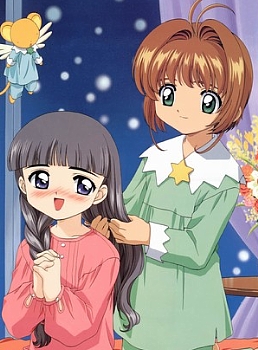
Tomoyo’s obsession with Sakura’s cuteness, having her dress up in different outfits while filming her, and ogling over how lovely she looks, is a little strange, but not too outrageous to well-rounded anime fans who have seen characters with all kinds of wacky fetishes. But I can only imagine what an average Westerner with little or no knowledge about anime would think. Probably upon hearing Tomoyo’s exclamation of Sakura’s cuteness, they would say “Is she a lesbian or something?” Of course, a lot of fans who have seen Cardcaptor Sakura don’t think that an elementary school girl like Tomoyo is a lesbian, but how would you explain her behavior to a non-anime fan? Is it that love in anime does not have to be that of romance or of simple friendship and family ties, but can exist somewhere else?

Another example in Cardcaptor Sakura is love between a child and an older person, i.e., Sakura and Shaoron’s crush on Yukito in the first half of the series, Sakura’s later fascination with Mizuki-sensei, and Rika’s crush on their teacher Terada-sensei. Though it’s later revealed that Sakura and Shaoron’s feelings came from the magic emitted from Yukito and Mizuki-sensei, any Westerner seeing these scenes would wonder why so many characters in a children’s show seem homosexual or have romantic thoughts about older people. Again, to anime fans, these kinds of strange, ambiguous relationships are nothing brand new, even for a kids shows, while Westerner’s would probably be appalled that this is considered appropriate. A difference in culture is the driving force for this distinction.

The last relationship in Cardcaptor Sakura I want to touch on is that of Yukito and Touya. By the end of the series, most fans believe that they shared a homosexual relationship, but again it was ambiguous; if I’m not mistaken, I don’t think they ever kissed or said “I love you,” but many pieces of evidence for their relationship are present. Besides the obvious idea of what’s appropriate for a children’s show, leaving things like this debatable for viewers instead of explaining everything, is another non-Western attribute that anime has.
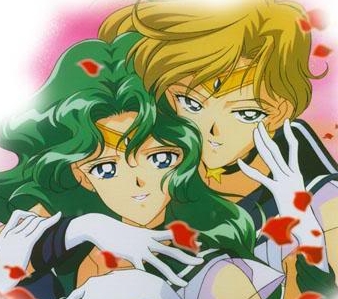
Another children’s show with a relatively obvious but never outright emphasized homosexual couple is Sailor Moon, and the relationship between Sailor Neptune (Michiru) and Sailor Uranus (Haruka).
Yet another anime with bizarre romances is Revolutionary Girl Utena. The main character, Utena, wants to become a prince, so she dresses like one and eventually forms a seemingly homosexual relationship with Anthy, the Rose Bridge she is meant to protect.
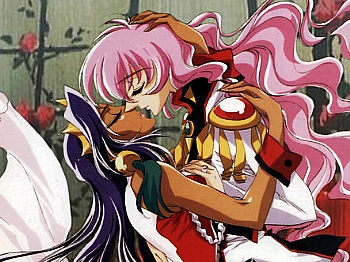
Once again, I don’t recall Utena and Athy ever actually stating plainly that they’re romantically in love with each other nor is it implied that they get sexually active; we only get numerous pieces of evidence that the two share a bond that goes beyond friendship, but may be a love that is not necessarily rooted in sex and romance. The other Utena characters also have their own bizarre romantic orientations.
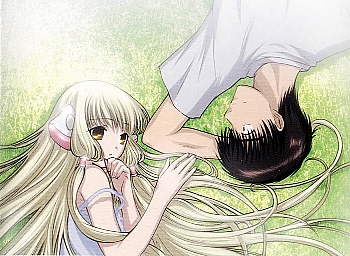
By the end of Chobits, we’re presented with a world where it’s okay for love to exists between a human and a humanoid computer. Could this really be true love?
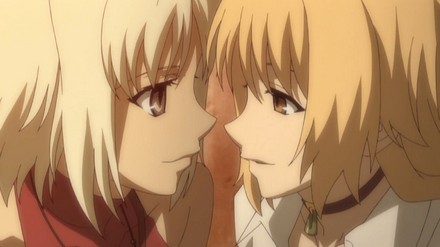
To use examples from newer anime, sharing a similar relationship as Utena and Anthy, the relationship between Canaan and Maria could also be interpreted as either homosexual or simply a love beyond friendship. The two talk constantly about how much they care about and need each other, but they never confess, kiss, or show any sexual interest.

Nadie and Ellis from El Cazador share yet another ambiguous relationship that seems like it’s beyond friendship but not explicitly romantic.
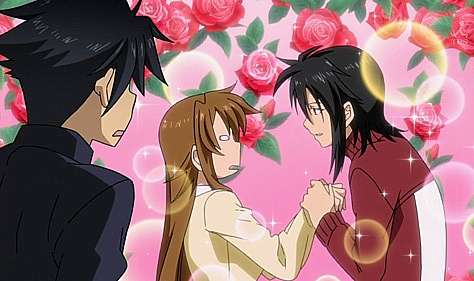
In the currently airing series Nyan Koi, because of past trauma, the tomboyish Nagi Ichinose loves girls instead of guys. But so far, her love hasn’t become anything serious or deep, and seems like it revolves more around fetishes and infatuations. She claims to be a “pursuer of beauty.” Not really sure how to define her sexual orientations.
I’ve picked out a few examples of notably strange romantic orientations in anime that might turn off, or at least puzzle, average Western viewers. But as most of us know, the majority of anime series deal with the basic girl+guy romance, though it’s common for multiple characters to be in love with the same character. Harems and love triangles add drama and suspense, and probably aren’t too outrageous for Western viewers. But what is different is again the ambiguity with which even typical heterosexual relationships are presented, particularly in the way characters constantly hide and deny their feelings of love.
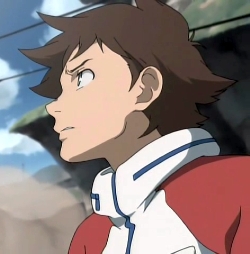
Of course, there are plenty of characters who actively proclaim their love, like Renton pictured above. But characters who are in love with each other and who actually kiss and/or say “I love you” at some point in the series are far fewer than the ones who never openly admit their love. Similar to the idea of what kind of relationships are appropriate for children’s shows, this concept stems from a cultural difference; Japan’s emphasis on formal relationships and not being too aggressive or outspoken about one’s feelings is reflected in anime.
A good example of this is the anime rendition of one of the most famous Western plays, Romeo and Juliet.
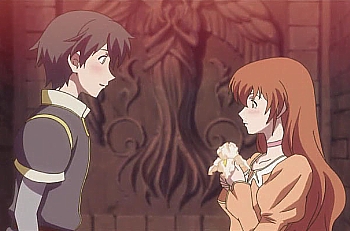
Watching how flustered and overtly “Japanese” Romeo and Juliet seemed upon their first meeting was quite amusing to me. It was more like a typical Japanese love confession, with both characters being shy and unsure, while most of us know how vastly different their exchanges are in the original play.
I wonder why Japan comes up with such strange and atypical relationships in anime. I’ll venture a guess and say that since anime is an escapist medium, and love is not something one should be publicly open about in Japan, bizarre romances in anime allow love to be a concept open to all kinds of things. And the ambiguous and uncertain way that these relationships are often presented helps maintain the “alternate world” of anime by keeping fans constantly pondering and debating about exactly how certain characters feel about each other.
Sorry, this was one of my longer posts. I congratulate anyone who actually read it all.
I agree with everything you said. Many relationships in animes are left for the viewer’s interpetation. I guess it’s up the viewer to figure out what they think is a true romantic relationship and not.
Really interesting post. There are definitely some cultural issues at play, although I wonder how much of it is driven more by pandering to otaku fetishes vs. a broader cultural element. E.g., would the average non-anime watching Japanese person find the relationships in Sailor Moon, Canaan, Cardcaptor weird?
The idea of the “confession” feels most definitely Japanese though. Or perhaps east-Asian, because it’s also present in Korean dramas and comedies I’ve seen. I suppose there’s a parallel in American tv, what with the asking of the first date, but that doesn’t seem to have the same level of importance and reverence that the confession has.
“The two talk constantly about how much they care about and need each other, but they never confess, kiss, or show any sexual interest.”
I don’t know why, but this made me laugh out loud.
Interesting point re: Romeo and Juliet. He didn’t even write a sonnet for her, like a good Renaissance gentleman should.
@ 2DT
Glad I gave you a good laugh XD
And yes, Romeo x Juliet should have had more poetry. Though I wonder how good a Shakespeare sonnet would sound when translated in Japanese.
This is definitely a good analysis/review over anime. I am an anime fan, and although I do notice this things in a little feeling of awkwardness, I am more or less familiar with it so it doesn’t confuse me that much.
But, if you think about it, not only in matters of anime, or TV shows for that matter, the Japanese thoughts and ideals are very apart from ours. It’s a different culture in its whole. The culture, the way they live their lives, the way they deal with problems or react to them, even the expression of emotions is amazingly different.
It has been like this almost since the beginning of times. In world’s history there aren’t many records of interactions between western and eastern people. Although we live and have always lived in the same planet, it’s as though as if the planet was divided in two halves, and which way grew on it’s own, and walked to different directions, getting further and further apart as the centuries went by.
I probably wouldn’t last long in Japan, not only because of the language, but because I would definitely be troubled by some of their traditions and ways. The same would probably happen to them if they were to come live to America or even Europe.
I believe anyone or anything can love watever they want. That’s their thing. Um I’m used to watching strange things so it doesn’t bother me and I think it makes the anime/show more interesting that way. Yes, some ppl who aren’t used to it might be disgusted or shocked. It all depends on the person. :) Nice article.
Plz check this poem out
http://authspot.com/poetry/spellbinding-bliss/
That was awesome. :) No one really understands anime in America but the few that do get this. Everyone else just thinks it is weird.
Generally, the real world is different from anime.Once a real person enters that other world, everything changes.In there(ANIME) anyone can fly–or be who they want to be.
The secret is knowing where you are.When yyou watch a bizzare anime, you should think like an anime character yourself.Which would mean, you opened your mind to all the possibilities.That way, you’ll avoid having culture shocks.When it is really important to know an anime’s culture, it would help if you are ANIME MINDED.In my case, I’m not japanese and yet by and by, I’ve adjusted to anime styles.
LOVE for example is different in anime.A boy gets to walk with a girl aND NEXT THING THEY KNOW–they’re already lovers(or something like that).While in the real world, a man can’t just marry a girl by walking beside her all day. =LOL (am I making sense here?) Oh well I love anime because it’s weird after all.
This was was incredibly interesting! I think about this all the time when I watch anime! The relationships are based on traits that the other finds attractive not where they are from, race or age, but a bond, and ultimately a connecting between characters.
I begun watching k-on a couple months ago l, and was thinking about introducing my little cousins to the anime. One of them is 9 and the other 6. Their parents heavily monitor what they watch, but allow me to show them things like sailor moon (classic, dubbed) and hamtaro (dubbed. They don’t speak Japanese or are Japanese, for that matter) because they trust me.
Upon watching K-on I can only say that the differences between Western world and Japanese/anime relationships differences are all too clear.
Yui( the main character) and her sister and she have this relationship that is close and very loving,( too loving for the almost hands off relationship between most American siblings) up to the point where her little sister cries when her big sister goes on a field trip. Yui and her sister are both on high school. Yui and her sister occasionally sleep on the same bed when one is lonely, and hold hands sometimes too.
-The members of their music club have a teacher/advisor that has huge a fetish for putting them in “cute” outfits such as maid outfits and things with cat ears also measuring who is cutest.
-Yui is just about obsessed with a girl in their club because of how cute she is. Yui also calls her Azu-nya because of how cute the girl looked in cat ears.
-And everything and everyone is cute cute cute.
This series highlights how prominent cuteness is in the Japanese culture, but i can’t show this series to my little cousins. Lol. A lot of it can be seen as lesbianism because of the distinct differences between the Western and Asian world. I don’t want them doing things seemed weird or taboo in the eyes of Anericans, especially their censoring parents.
Since this is an older post of yours I don’t know if your views have changed, but calling a different approach to romance “weird” just because it comes from a different culture is what’s weird to me. As you mentioned, Japanese aren’t avid fans of displaying their emotions publicly, but you also forget to take in account the demographics and how queer biting works. In an action-driven series like CANAAN it’s only natural you won’t get explicit expressions of romantic love. It’s also profitable to imply lesbian romance -mainly for the male viewers- and not have it canonically displayed just to open shlashing possibilities for the fans. Cardcaptor Sakura is aimed towards kids so the way things are introduced will be age-appropriate. If you’ve seen CCS only from dub you certainly have missed the pretty clear admission of Yukito that his special someone is Touya. Tomoyo /is/ a lesbian in a way that mirrors her mother’s infatuation with Nadesico. CLAMP had said outright that CCS is a story where they show respect towards all kinds of love (I won’t comment on the icky pedophilic one between Terada and Rika). But also be careful of how US-centric -I suppose- your whole approach is. In Greece where homophobia can get intense I was never told for example that having a crush on my female teacher was sth more than platonic love, and that wasn’t reprimanded. So I didn’t see as strange Syaoran’s crush on Yukito.
So what makes one right and the other wrong?